Louise Cullen & Hayley Halpin
BBC News NI

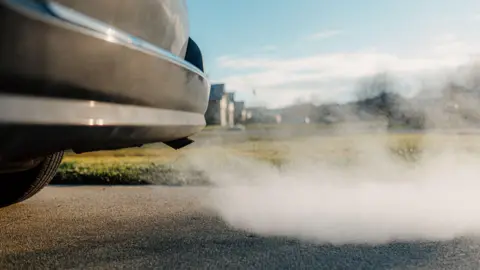 Getty Images
Getty Images
Transport is the second largest source of emissions in Northern Ireland.
Northern Ireland's first draft Climate Action Plan has been published for consultation.
It is a roadmap to support emission reduction targets across nine sectors, including energy, transport, waste management and agriculture.
It sets out how Northern Ireland will meet its 2023-2027 carbon budget target of cutting emissions by an annual average of 33%, compared to the base year of 1990.
The plan is led by the Department of Agriculture, Environment and Rural Affairs (Daera) and is a legal obligation under the Climate Change Act which must be renewed every five years.
So, what does the plan set out for different areas of society?
Energy production

 Getty Images
Getty Images
Cows graze on a field beside wind turbines on Slieve Rushen wind farm, in Derrylin, County Fermanagh
The Climate Change Act (Northern Ireland) 2022 sets out a target of at least 80% of electricity used in Northern Ireland to come from renewable sources by 2030.
The CAP outlines that the goal is to produce more clean energy, such as wind and solar power to achieve the 80% target.
There are plans to continue a support scheme that has helped NI generate more renewable energy and have rules to control certain harmful gases that can damage the environment.
The CAP proposes a new programme to encourage more renewable electricity.
Farming and agriculture

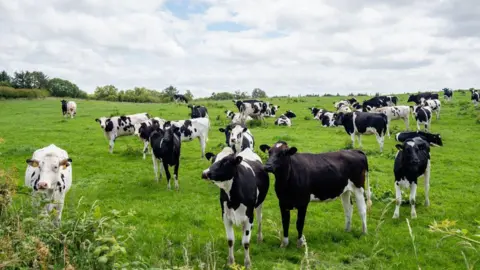 Getty Images
Getty Images
Agriculture is the largest emitter in Northern Ireland.
The UK's Climate Change Committee has previously recommended "radical action" for Northern Ireland to reach its goals, including reducing livestock numbers to reduce emissions in farming.
The draft plan does not act on that recommendation.
Instead it relies on improving farm productivity through genetics, soil testing and novel feeds, encouraging low carbon farming practices and increasing the use of slurry for energy through biomethane generation to cut emissions in the farming sector.
The CAP outlines that the Sustainable Agriculture Programme will help farms become more environmentally friendly and work better together, to reduce greenhouse gas emissions in farming in Northern Ireland.
Business and industry
Business and industry is responsible for 11.9% of Northern Ireland's greenhouse gas emissions, according to the CAP.
The CAP outlines that businesses and industries in NI follow many UK plans.
There are also plans in place for NI to help the economy. These include:
- Checking how well heating and power systems use energy and how they affect the environment
- Making buildings more energy efficient
- Setting rules on emissions (pollution from businesses), product design, and labelling
- Requiring businesses to report their emissions and offering funding to help them improve
- Encouraging the use of natural gas instead of other fuels
- Updating Northern Ireland's building rules
Transport

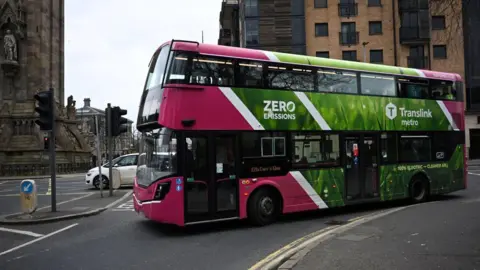 Getty Images
Getty Images
The CAP says vehicle emissions will be reduced by switching fuels to zero and low emissions alternatives
Transport is the second-largest source of emissions in Northern Ireland.
The CAP says vehicle emissions will be reduced by switching fuels to zero and low emissions alternatives.
The plan proposes shifting modes of transport away from private car journeys to sustainable travel alternatives like walking and cycling.
It also proposes reducing the need and length of vehicle journeys.
Residential and public buildings
Emissions from Northern Ireland's homes have fallen by 31.4% between 1990 and 2022, according to the CAP.
Emissions from residential buildings are mainly due to the use of fossil fuels for heating and generating hot water.
The CAP says in order to cut down emissions, cleaner ways to heat homes will need to be used.
This means switching to fuels like natural gas and using new heating systems that run on electricity.
It is also planned that how homes are built will be improved to make them easier to heat, along with making homes use less energy to help reduce how much power is used.

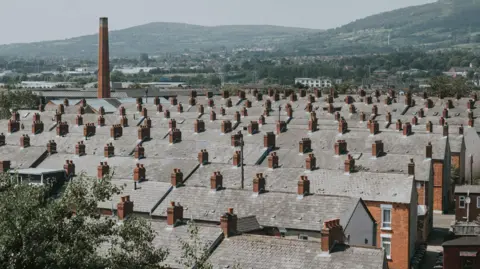 Getty
Getty
Emissions from residential buildings are mainly due to the use of fossil fuels for heating and generating hot water
Waste management
Waste accounted for 3.6% of total Northern Ireland's greenhouse gas emissions in 2022, according to the CAP. This rose to 4% in 2023.
Household recycling rates have increased from 10% in 2010 to just over 51% in 2023-2024.
The law sets a target to recycle at least 70% of waste by 2030.
The CAP says reducing emissions in waste will be achieved by:
- Making improvements to how food waste is collected from households and less biodegradable waste going to landfill
- Increasing recycling rates and improving quality of the material that is collected for recycling
Land use and forestry
Land use and forestry emissions represented 10.1% of total annual emissions in NI in 2022, the CAP outlined.
This rose to 12% in 2023.
The CAP says in order to help the environment, a reduction in pollution is needed, along with absorbing more carbon from the air.
The plan states:
- The Forests for Our Future plan will create 9,000 hectares of new woodland by 2030.
- The Northern Ireland Peatland Strategy will help protect these important habitats.

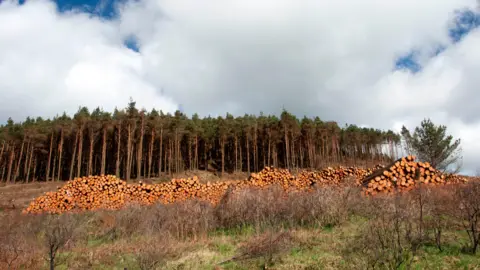 Getty Images
Getty Images
A pile of conifer tree trunks in front of a forest in Northern Ireland
Programmes such as Farming with Nature and the Soil Nutrient Health Scheme will support farmers in caring for the land while helping the environment.
It should be noted that at the halfway point of the Forests for Our Future plan, about 2,000 hectares have been created, a shortfall the Woodland Trust described as "a missed opportunity".
The conservation charity's Northern Ireland director John Martin said "urgent and sustained action" was needed.
"Every tree planted is a legacy of hope, resilience, and renewal for generations to come," he said.
"Now is the time to reinvigorate our collective commitment to woodland creation and management in Northern Ireland."
Fisheries
Fisheries is the smallest emissions sector, accounting for 0.1% of NI's greenhouse gas emissions in 2022.
There are plans to invest in research to find new ways to make fishing boats less harmful to the environment.
There are also plans to prepare for change by exploring the use of electric boats and low or zero emission fuels.

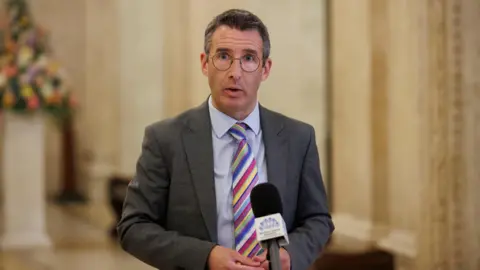 PA Media
PA Media
Minister Andrew Muir says the consultation is a "milestone moment"
Announcing the consultation, the Daera minister said it was a "milestone moment" in addressing climate change.
"We have seen the damaging and costly impacts of climate change around the world and closer to home from flash flooding, wildfires and more frequent and severe storms," Andrew Muir said.
"No section of society is immune. It is essential we take action and I would encourage everyone to take part in this 16-week consultation."
Analysis: Questions over speed of action
By BBC News NI agriculture and environment correspondent Louise Cullen
The consultation on this draft plan may well be greeted with a cry of, "at last" from campaigners.
The final plan should have been laid at the end of 2023, but better late than never.
As the lead department, Daera is confident the plan puts Northern Ireland on the trajectory to meet the first carbon budget target – much of the estimated £718m cost has already been invested with many of the policies and proposals referenced in place.
But some of those policies are proving slow to get off the ground.
"Future generations will thank us for stepping up to this challenge of our lifetimes," ends Muir's statement.
But how quickly we move now will be the decider.
During the 16-week consultation there will be 10 public events and 2 online sector-specific sessions for people to attend.
The consultation will close on 8 October.









 English (US) ·
English (US) ·